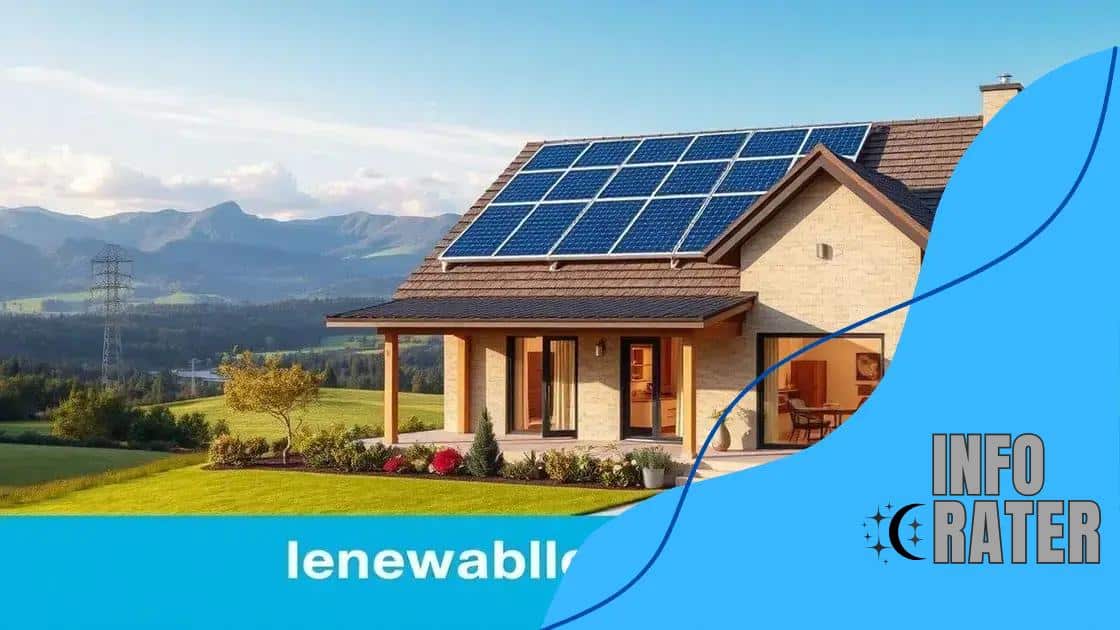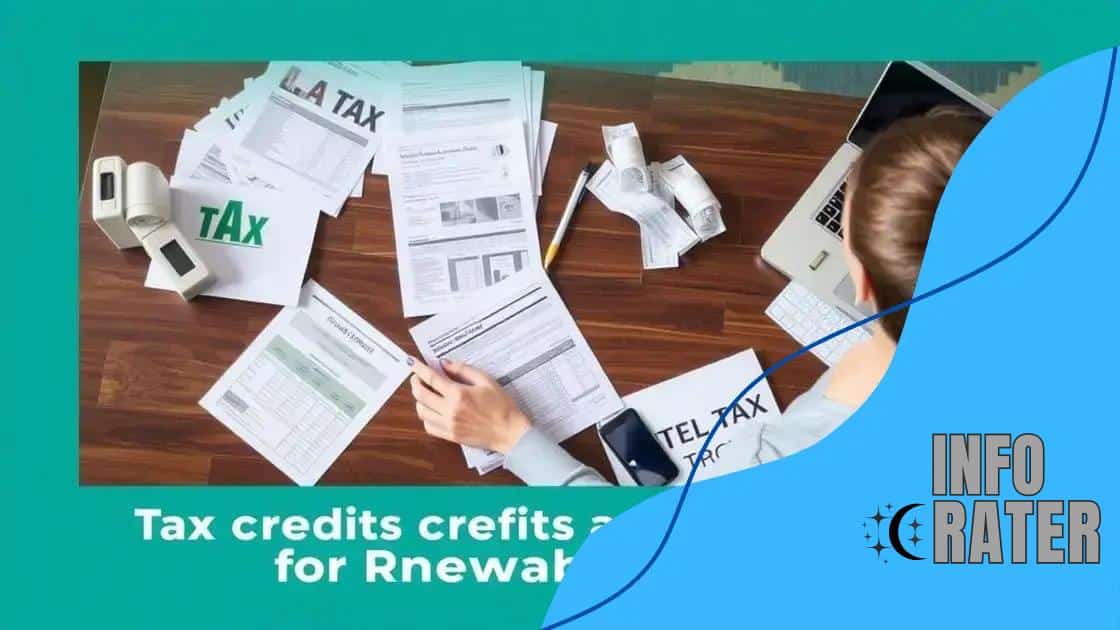Renewable energy tax incentives for homeowners

Renewable energy tax incentives for homeowners significantly lower energy costs, increase home value, and provide access to various federal and state tax credits, making them a smart investment for sustainability and financial savings.
Renewable energy tax incentives for homeowners present exciting opportunities to lower your energy costs and enhance your property’s value. Have you ever wondered how these incentives can help you save money while contributing to sustainability? Let’s dive into the essential details!
Understanding renewable energy tax incentives
When it comes to saving money on your energy bills, understanding renewable energy tax incentives can make a significant difference. These incentives help homeowners offset the costs of installing renewable energy systems, making it easier to invest in sustainability.
What Are Renewable Energy Tax Incentives?
Renewable energy tax incentives are programs offered by the government to encourage the adoption of clean energy. They come in various forms, such as tax credits, rebates, and grants, which can help reduce the financial burden on homeowners.
Types of Incentives Available
- **Federal Tax Credits:** Homeowners can claim a credit on their federal taxes for a percentage of the cost of solar, wind, or geothermal systems.
- **State Incentives:** Many states offer additional tax credits, rebates, or performance-based incentives on top of federal programs.
- **Local Utility Programs:** Some utility companies provide rebates or financing options to encourage the use of renewable energy sources.
By leveraging these incentives, homeowners can significantly reduce their initial investment and improve their overall savings.
Understanding the eligibility criteria is essential for taking advantage of these offers. For example, residential solar panel installations are often qualified for federal tax credits, but the system must meet specific efficiency standards and be installed within defined timelines to qualify.
How to Apply for Incentives
Applying for renewable energy tax incentives can be straightforward if you follow the right steps. Generally, you need to:
- Do your research on available incentives in your area.
- Keep all documentation of your renewable energy purchases and installations.
- Fill out the necessary forms when filing your taxes.
This process can vary based on state and local regulations, so it’s critical to stay informed. Remember that staying updated with changes in laws and incentives can play a crucial role in maximizing your savings.
Types of renewable energy systems eligible for incentives
Several renewable energy systems are eligible for tax incentives, making them affordable options for homeowners. Understanding these systems can help you make informed decisions on which to choose for your home.
Solar Energy Systems
Among the most popular options, solar panels harness sunlight to produce electricity. This technology is widely available, and many states offer generous tax credits and rebates for solar installations. The Federal Investment Tax Credit (ITC) allows homeowners to deduct a significant percentage of the installation costs from their federal taxes.
Wind Energy Systems
Small wind turbines are another viable option for generating clean energy. They can be installed in residential areas where there is adequate wind speed. Homeowners are often eligible for federal tax credits that cover a portion of the installation costs.
Geothermal Heating and Cooling
Geothermal systems use the earth’s constant temperature to heat and cool homes efficiently. These systems can significantly lower energy bills and are eligible for various incentives, including federal and state tax credits. Homeowners can benefit greatly from the long-term savings and environmental advantages they offer.
- **Hydropower Systems:** Small-scale hydropower systems can also qualify for incentives, depending on location and output.
- **Biomass Energy Systems:** These systems convert organic materials into renewable energy and may also qualify for financial assistance.
- **Fuel Cells:** Some homeowners choose fuel cell systems, which convert chemical energy directly into electricity, and may receive tax incentives.
The eligibility of these renewable energy systems can depend on local, state, and federal regulations. Homeowners should research each option’s requirements to ensure they maximize their savings.
By exploring the various types of renewable energy systems available, homeowners can find the best solutions for their needs while taking full advantage of the incentives offered.
How to claim tax credits and deductions

Claiming tax credits and deductions for renewable energy investments can seem complicated, but it is an essential step to maximize your savings. Many homeowners experience confusion about the process, yet breaking it down can make it manageable.
Gather Required Documents
To start, gather all necessary documentation related to your renewable energy installation. This includes receipts, manufacturer’s certifications, and installation contracts. These documents will be crucial when completing your tax return and claiming credits.
Determine Eligibility
Next, it’s essential to know which tax credits you qualify for. The Federal Investment Tax Credit (ITC) allows homeowners to deduct a portion of the installation costs for solar panels and other systems. Check your local and state regulations as well, as each may offer additional incentives.
- **Check for Home Certification Requirements:** Ensure that your installation meets energy efficiency criteria.
- **Include Systems Installed Next Year:** Many credits allow for systems installed in the previous year.
- **Consult a Tax Professional:** If you are unsure about eligibility or requirements, seeking help can clarify your situation.
Once you’re familiar with the necessary documents and eligibility criteria, you can proceed to fill out the appropriate forms during tax season. Most homeowners will use IRS Form 5695 to claim these credits.
Ensure that you take time to complete the form accurately. Mistakes can delay your credits, so double-check all entries and include any required documentation with your tax return.
Filing Your Taxes
When it’s time to file, include your claim forms with your federal and state tax submissions. If filing online, most tax software will prompt you for information regarding energy credits and deductions.
After submitting your forms, keep copies of everything for your records. The IRS may require additional documentation in the future, and having your files organized will make this process easier.
Common misconceptions about renewable energy incentives
Many homeowners hold misconceptions about renewable energy incentives, which can prevent them from taking full advantage of available benefits. Understanding these myths can clarify opportunities and encourage more people to invest in renewable energy.
Myth 1: Only Wealthy Homeowners Can Benefit
One common myth is that renewable energy incentives are only for wealthy homeowners. In reality, many programs cater to various income levels. For example, federal tax credits and state grants are designed to help homeowners of all financial backgrounds afford renewable energy solutions.
Myth 2: The Process is Too Complicated
Another misconception is that claiming these incentives is overly complicated. While there are forms and criteria to meet, the process is often simpler than it seems. Homeowners can find numerous resources online and seek help from tax professionals to understand how to apply for tax credits and other incentives.
- Some people believe they can’t install solar panels because they rent their homes. However, many organizations offer financing solutions, making it possible for renters to benefit as well.
- Many assume that the setup costs are prohibitive, forgetting that incentives can significantly lower these expenses.
- Some people think incentives are only for specific types of renewable energy. In fact, various technologies, such as solar, wind, and geothermal, can all be eligible.
Understanding these common misconceptions can empower homeowners to explore renewable energy options. It’s important to stay informed about the incentives available in your area.
By debunking these myths, more homeowners can access and benefit from programs designed to promote sustainability and energy efficiency.
The long-term financial benefits of renewable energy investments
Investing in renewable energy offers significant long-term financial benefits for homeowners. When you switch to renewable energy sources like solar or wind, you can save money on energy bills while also increasing your home’s value.
Lower Energy Costs
One of the most immediate financial benefits is the reduction in monthly energy costs. By generating your own energy, you rely less on your utility provider. This means significant savings on your bills, especially as energy prices continue to rise. Many homeowners see up to a 50% reduction in their electric bills after installing solar panels alone.
Increased Home Value
Homes equipped with renewable energy systems often attract higher resale values. Studies show that homes with solar panels sell for a premium compared to those without. This is because buyers are willing to pay more for homes that offer energy savings and lower utility costs.
- **Tax Credits:** When you invest in renewable energy, you often qualify for federal and state tax credits, which can cover a significant portion of your installation costs.
- **Incentives and Rebates:** Local and state governments frequently offer incentives for renewable energy installations, further lowering your investment costs.
- **Loan Programs:** Various financing options are available that allow homeowners to invest in renewable energy without upfront costs. These programs can make it easier to install solar or wind systems.
Long-term, investing in renewable energy can provide a hedge against inflation. As traditional energy costs rise, having your own energy source can insulate you from these increases. Moreover, renewable energy technologies have lower maintenance costs than conventional energy systems, leading to even greater savings over time.
Overall, the financial benefits of renewable energy investments can significantly outweigh the initial costs, contributing to a more sustainable and economically sound future.
In conclusion, investing in renewable energy is a smart choice for homeowners. It can lead to significant savings on energy bills and increase the value of your home. With various tax credits and incentives available, the initial investment can be less daunting. By dispelling common misconceptions, more homeowners can enjoy the financial and environmental benefits of renewable energy. Embracing these options not only helps individual finances but also contributes to a healthier planet.
FAQ – Frequently Asked Questions About Renewable Energy Tax Incentives
What are renewable energy tax incentives?
Renewable energy tax incentives are programs that allow homeowners to reduce their tax bills by investing in renewable energy systems, such as solar or wind.
How can I qualify for these incentives?
Eligibility often depends on the type of renewable energy system you install and adherence to specific guidelines set by federal and state programs.
Will switching to renewable energy save me money?
Yes! Investing in renewable energy can lead to lower energy bills and increased home value over time, along with potential tax savings.
Are there common misconceptions about renewable energy incentives?
Many believe these incentives are only for wealthy homeowners or that the application process is too complex, but that is not true. Incentives are available for various income levels.





